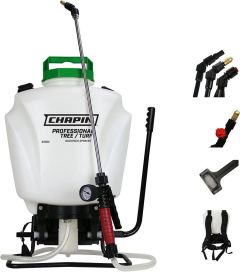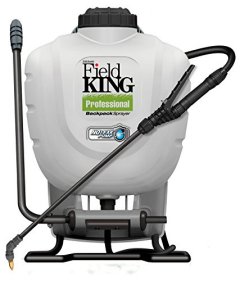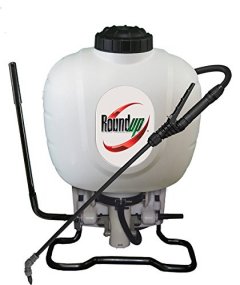Buying guide for best backpack sprayers
Pesky bugs or noxious weeds can choke out natural vegetation, flowers, and vegetable gardens. A backpack sprayer gives you the power to push back against pests.
Backpack sprayers have either a manual or motorized pump that allows you to spot-spray, reach confined spaces, and work on uneven terrain. With the right list of features, including nozzles, adjustable harness, and wand extensions, you can be outfitted for maximum coverage in a short amount of time. These tools come in different capacities and with comfort features like adjustable straps and contoured tanks, so you can kill unwanted garden intruders in relative comfort.
We at BestReviews have put together this shopping guide to take you through the pros and cons of the different types of backpack sprayers, as well as the features and accessories that can make quick work of fertilizing, killing weeds, and pest control. And when you’re ready to buy, check out the backpack sprayers that we think stand out from the rest.
Key considerations
Types of backpack sprayers
Manual: Manual or hand-pumped backpack sprayers are the most common type because of their ease of use and low price. This type comes in two variations: the piston pump and the diaphragm pump.
- Piston pump: These pumps use a piston within a cylinder to push liquid out of the tank. With this type of pump, all of the components directly contact any liquids used. These models are usually less expensive, but because the pump is exposed to all chemicals, they can’t be used with all herbicides and pesticides. And depending on how often and what kind of products you’re using in the tank, a piston pump can wear out more quickly than a diaphragm pump.
- Diaphragm pump: A diaphragm pump uses a flexible membrane to displace fluids and power them out of the tank. While these models are more expensive, only certain pump components come into direct contact with the tank’s contents. In general, this type is easier to maintain and not as easily damaged by contact with herbicides and pesticides.
Motorized: Motorized backpack sprayers can move a serious amount of liquid through the tank in a much shorter time than manual models. These come in two basic types: powered by battery and powered by gas.
- Battery: Battery-powered backpack sprayers typically use a rechargeable lithium battery. These models run for as long as a single charge lasts, which ranges from 1.5 to 10 hours. The length of the charge depends on a few different factors, including the viscosity of the liquid and the pressure settings of the sprayer. Battery-powered models cost more than hand-pumped sprayers, but they're often worth it if you have a lot of ground to cover.
- Gas: Most gas-powered backpack sprayers are professional-grade tools. The gas tank makes them far heavier than the other types, but that often means they have a superior harness design. If you have a lot of property or run a small landscaping business, one of these expensive 20- to 25-pound sprayers can save you time and money in the long run.
Weight
Once you add liquid to the tank, a backpack sprayer can be a fairly heavy load. Some gas-powered models weigh as much as 30 pounds empty. Add four to six gallons of liquid and you're looking at a possible load of 70 to 80 pounds. A lightweight, manual model will save your back and shoulders, but be sure it has a well-padded harness with adjustable shoulder straps for added comfort.
Backpack sprayer features
Wand
The wand is what really allows you to reach into those tight spaces. Some sprayers come with a wand extension, but if not, you can buy one separately. Take a good look at the grip on the wand, too. It should fit your hand well. Models with finger grips are often easier to hold. Models with a lockable trigger maintain a consistent spray while giving your hand a rest.
Nozzles
Spray: Nozzles affect the pressure and spray pattern. Most sprayers come with several nozzles, and if a model doesn’t have the nozzle you want, it can be purchased separately. The most common and useful include cone, fan, direct stream, and adjustable.
Material: But it’s not just the type of nozzle you need to consider. You also need to think about the materials that go into the nozzle. The least expensive are made of plastic, but plastic degrades more quickly than other, pricier options, including bronze, brass, and nickel. If you’re looking at a long-term solution to your pest and weed problems, opt for a nozzle made of one of these more durable materials.
Harness
A harness spreads the weight of the sprayer across your shoulders and hips. The more adjustable the harness, the more comfortable you’re going to be because you can customize the fit to your body. Harness features that can make a difference in your comfort include the following:
- Shoulder straps: You want padded, adjustable straps that help prevent the weight of the sprayer from cutting into your shoulders.
- Back supports: These put some padding between your spine and the hard plastic of the tank. Designs with mesh over the padding also increase breathability.
- Chest strap: This holds the shoulder straps together across the chest so they stay in place while you move.
- Hip strap: This takes some of the weight of the sprayer off your shoulders and puts it on your hips.
Tank
Capacity: Tank capacity ranges from two to over six gallons. Since a gallon of water weighs approximately eight pounds, anything larger would make the sprayer too heavy for most people to carry.
Shape: While capacity is important, take a look at the shape of the tank, too. A contoured model will better fit your torso than a boxy shape.
Did you know?
The highest-grade sprayer tanks are made of polyethylene and include UV protection.
STAFF
BestReviews
Filtration
Dirt and debris can easily fall in the tank while you’re filling it with solution. Models that include internal tank filtration prevent debris from reaching the hose and clogging the wand or nozzle. Some models also have a small filtration system in the wand itself to prevent clogs. You will need to periodically replace the filters.
Extras included
Depending on the sprayer you buy, it might come with some accessories, including the following:
- Extended hose
- Spare seal kit
- Foldable pump handle (locks away when not in use)
- Reversible handle (fits right or left side)
- Extra filters
Extras sold separately
There are a lot of useful extras that are sold separately. Depending on how you’ll be using the sprayer, some of these might be worth adding to your purchase:
- On-tip on/off switch: Factory wands don’t include this feature, but it’s a valuable add-on that can prevent drips.
- Pressure regulator: This fits on the wand to control the spray pressure. It can even out the coverage and application as well as prevent drift.
- Quick couplers: These make it easy to take the sprayer apart for storage.
Backpack sprayer prices
Inexpensive: Backpack sprayers start at $30 to $50. These manual sprayers have two- to five-gallon tanks. The shoulder straps aren’t usually padded, and the harness doesn’t include hip or chest straps.
Mid-range: The vast majority of manual pump sprayers (both piston and diaphragm) fall in this price range, coming in between $50 and $100. Adjustable, padded shoulder straps and four-gallon contoured tanks are the norm.
Expensive: Battery-powered models fall in the $100 to $300 range. The quality of the harnesses and nozzles increases at the higher price points.
Premium: Gas-powered models round out the top of the market, running between $300 and $800. Tanks range in size from four to over six gallons with a two- or four-stroke gas-powered pump. These sprayers might come with multiple wands and tips, too.
Tips
- Think about the size of your property. A two- or three-gallon manual sprayer can make quick work of a postage-stamp-size piece of property. However, if you have a large area or you want to use the sprayer as part of a landscaping business, you would be better off investing in a large gas-powered model.
- Think about what you’re going to use the sprayer for. Do you want to spray weeds or spread fertilizer? Your purpose will determine the types of nozzle(s) you need. If you’re spreading pesticides, you might need the coverage of a hollow or full-cone nozzle that can cover a lot of area with a single spray. Streaming nozzles are excellent for applying fertilizer.
- Spray consistently. For the best coverage and uniform spray, it’s important to hold the handle at a consistent pressure and move the wand at a steady rate.
Other products we considered
With our list limited to five, we had to leave out a few sprayers that we also liked, but one of these might be perfect for your circumstances. The Field King Max 193048 Backpack Sprayer offers some premium features at a reasonable price. It comes with four nozzles and includes an in-line filter at the top of the wand to prevent clogs. And the pro-grade harness is comfortable to wear even when the tank is full. The Hudson 13854 Never Pump Bak-Pak is a battery-powered model that keeps spraying for up to ten hours. The four included nozzles and wide tank opening make this a sprayer worth considering.
FAQ
Q. What kind of maintenance does a backpack sprayer require?
A. Sprayers should be completely emptied and rinsed with water after each use to prevent corrosion from any chemicals left in the tank or hose. It usually takes at least a gallon of water to fully clean the tank, but it might take more depending on the chemicals and tank size. Gas-powered pumps take more maintenance because they need winterizing with antifreeze during cold months. If the sprayer has been sitting for a while, be sure to check and lubricate the O-rings and seals before using it.
Q. Do backpack sprayers leak?
A. Most tanks are made of polyethylene, which can withstand most harsh chemicals as long as the tank is flushed out after each use. Nozzles, however, are the most common source of leaks. Wands with an on/off mechanism can stop liquid from making its way to the nozzle when the sprayer is not in use.
Q. How can I tell if a nozzle needs to be cleaned?
A. Some liquids are more viscous than others, which can lead to clogs. Before mixing your solution, check the spray pattern of the nozzle using water. If the pattern isn’t uniform, clean the nozzle by removing it and soaking it in warm water. That might be enough to loosen any debris and clear the nozzle. If not, try gently cleansing it with an old toothbrush. Some nozzles can be taken apart for further cleaning, but most will be ready to go after a good soak and scrub.




















